
Tropicals > Pinus > Pinus kesiya > Pinus kesiya
Pinus kesiya
Khasi Pine, Benguet Pine
Origin: China, India, Malaysia, Philippines, Myanmar and Vietnam
Mike's
Opinion


"
Pinus Kesiya (Khasi Pine) is a sub tropical to mildly temperate tree and grows in the mountains of China, India, Vietnam, Malaysia, Myanmar and the Philippines. It prefers to grow in moist soils but it can also grow in sandy soils too. This is quite a unique tree having many different characteristics from the North American pines such as shape, use and growth habits.
Michael Pascoe, NDP., ODH., CLT., MSc. (Plant Conservation)
"
| Family |
| Pinaceae |
| Genus |
| Pinus |
| Species |
| kesiya |
| Category |
| Tropicals |
| Type |
| Tree (evergreen) |
| USDA Hardiness Zone |
| Zone 9 |
| Canadian Hardiness Zone |
| Requires cold protection since it is frost sensitive. |
| RHS Hardiness Zone |
| H2 |
| Temperature (°C) |
| 10 - 30 |
| Temperature (°F) |
| 50 - 86 |
| Height |
| 30 - 35 m |
| Spread |
| 10 - 15 m |
Photographs
Description and Growing Information
Flowering Period
| General Description |
| Pinus kesiya is a tall, monoecious evergreen tree that almost always grows in areas described as subtropical or mildly temperate. It grows to heights of 45 m and its bole is branchless for up to 20 m. It grows in succession with Pinus merkusii and Quercus castanopsis. Pinus kesiya is a tall, straight trunked tree that bears conical fruit 23 months after flowering. Its bright green needles are long, erect but soft and are found in arrangements in fascicles of 2-4. The tree has deeply fissured pink to reddish-grey bark. It can help the regeneration of a forest because it can grow quite well after a stand has been decimated by fire. |
| Landscape |
| There are over 100 species of the Pinus tree. The Pinus kesiya is not native to North America, so many of the landscaping properties (such as a windbreak) of other Pinus species do not apply. This particular species of tree can be used as an ornamental or exotic tree because the natural habitat is so different from that of the Canadian climate. In its natural habitat, these trees are often found in mixed, open stands on fire prone hillsides. |
| Cultivation |
| This tree likes to grow in moist soil but is tolerant of variations in soils, as it can grow in either sandy soils or soils with a high clay content at elevations of 300 - 2700m. If this tree is growing in moist soils it will more than likely develop a single dominant taproot. If grown in well drained soils with a higher porosity than moist soils it will grow many long fibrous roots very close the surface. These trees are often found in mixed, open stands on fire prone hillsides. |
| Shape |
| The Pinus kesiya tree is pyramidal while young, rounded and open when mature. It has a straight growing trunk with no branches for the first 15-20m. Its trunk can be up to 100 cm in diameter. As it grows the crown opens and it becomes a narrow dome shape. Often its horizontal branches are thinly covered with foliage near its tips. |
| Growth |
| Fast |
| ID Characteristic |
| It is an adaptable tree because it can grow in former fire ravaged zones allowing smaller, less adaptable plants to be grown around it, thus starting the important regeneration of the forest. This tree is unique to the species because of its form. Most pines are pyramidal in shape with branches that grow from the base of the trunk to the tip. This tree is different because it lacks branches for the first 20 metres. The final identifier is the literal shape of the tree, it has a less uniform growth pattern. The branches of the tree grow in a more sporadic manner, making it look more like the growth of a deciduous tree than a coniferous. |
| Pests |
| The pine wooly aphid (Pineus pini) causes the tree to lose its needles before it is supposed to. These female wingless insects are usually dark brown or red, round in shape and covered in a white wool that is usually very waxy to the touch. The winged female insects are usually a reddish-grey colour. This tree is also prone to Dothistroma needle blight. In fact, up to 50 percent of the foliage could be gone while the tree is infected. Dothistroma needle blight is a severe fungal disease caused by the fungus from Dothistroma septosporum, it can be identified by the red and even sometimes brown spots left on the needles of the tree, starting off as random dots which sometimes grow into a ring around the needle. It is an extremely slow moving disease, sometimes taking an entire year to infect the whole tree. If you find an infected tree one of the best things to do is to prune the lowest branches, allowing for a more abundant nutrient intake of the infected area. |
| Habitat |
| This tree grows most naturally in the mountains of India, Thailand, Burma, Laos, southernmost China, Vietnam and the Philippines. It grows at an elevation between 300-2700m high. It needs quite a moist environment, needing about 1000-2000mm of rainfall each year, not including the dry months of anywhere between 2-4 months. The soil requirements of this tree is very wide, it grows naturally in well drained acidic soil as well as sandy soils. Once the tree stand is established, it is adaptable to changes in the environment (like frost and drought). Because of its adaptability, it is likely that you will find this tree where there has been recent fire damage. |
| Bark/Stem Description |
| The bark of this tree is thick, dark brown, with deep fissures running along the length of the bark. (2.5-4.5cm thick). Its bark is covered with long crevices that are filled with resin. Adult trees often lose bark as it flakes off in thick, irregular and sometimes silver coloured pieces. As the bark gets more exposed to the natural elements the colour actually darkens. The bark on this tree is quite easy to saw and it can be worked with virtually any tool. The high resin content inside the bark and wood can cause the tools used to get dull extremely quickly. |
| Flower/Leaf Bud Description |
| The buds are terminal and pointed with an elongated cone shape or sometimes a cylindrical shape to them. Buds do not contain resin, making this feature very different from the rest of the tree. The buds are covered in scales that are finely acute and are exposed at the points with a thin, dry and membranous jagged or torn margins. |
| Leaf Description |
| The leaves are needle-like, dark green, usually 3 per fascicle, 15-20 cm long. The fascicle sheath is 1-2 cm long and persistent. Pinus kesiya has flexible bright green needles found in fascicles on the branches. The foliage ranges from bright green (when young) to a soft dark green (as the tree matures). |
| Flower Description |
| The Pinus kesiya is a monoecious evergreen, which means they bear both male and female flowers on the same plant. You are able to see the male flowers on this tree at the beginning of November. From then on the male flowers will shed pollen until the end of February. The female flowers, however, emerge midway through December only for about 2 months until the start of February. The male strobili are 3.5 - 5 cm, oblong and a bright yellow or brown colour, while the female cones are grouped up to 3 together on a short stalk (approximately 1 cm long). Female cones (4-5 cm) hang down from their stem loosely and are egg or cone shaped. They are shiny and have wood-like scales. |
| Fruit Description |
| The cones are ovoid, 5-9 cm long, often curved downwards, sometimes slightly distorted; the scales of second-year cones are dense, the umbo a little convex and sometimes acutely spinous. The scales have transverse and longitudinal ridges across the midd-rib. |
| Colour Description |
| The heartwood of this evergreen ranges from red-yellow to red-brown and it tends to darken when exposed to sunlight. The foliage of the Pinus kesiya is bright green and the bark is pinkish to reddish-grey. Its branchlets have a waxy bloom (a whitish film). The wood of this tree contains several visible canals for its resin. They can be identified by long, straight brown scratches on its vertical surfaces. The resin itself is pale yellow. The trees male cones are bright yellow or pale brown, while the female cones are greenish-purple when young and bright and shiny brown when mature. |
| Texture Description |
| The Pinus kesiya is pruinose, which means it is covered with a grey or white coloured powder. This often gives it a waxy feeling. The bark of this evergreen tree often flakes in small, thick and sometimes silver coloured plates. While the bark of the Pinus kesiya is coarse or rough to the touch. Once you finally remove the harsh exterior that is the bark, the wood left over is very smooth to the touch. The grain of the heartwood is straight and its texture ranges from medium to fairly coarse and uneven. |
| Notable Specimens |
| A specimen of this tree can be found as the most abundant species in the forest in the Luzon Tropical Forest in the Philippines. This is a protected forest because of its uniqueness. Located in the mountains of the Philippines. It is a huge grassland containing a large number of naturally growing Pinus kesiya; this species of pine flourishes there because of the climate and the fires that plague the forest of the Philippines. Queen Sirikit Botanic Garden, Chiang Mai, Thailand. |
| Propagation |
| This tree is most commonly propagated by seed. It produces seeds every year which are spread by wind (also by birds, rodents or people). Propagation is also possible through cuttings, grafting or air-layering. Some preparation is needed to properly plant this tree. To help germinate the seed it is necessary that it sits in a bath of hot water that is 40-50 degrees celsius. It is best to soak the seed in a cool water bath overnight before planting. This is also very beneficial for the germination of the seed. It is almost completely necessary to inoculate the seed before planting it. |
| Ethnobotanical Uses (Disclaimer) |
| Along with all pine trees the resin that can be extracted from Pinus kesiya is very valuable and can be used as an antiseptic, diuretic, and vermifuge as well as in the manufacturing of paper. This resin can also be used as a vanilla flavouring. In the Philippines the resin was used to manufacture turpentine in the Spanish Colonial Era. The resin, branches and wood can be used for medicinal purposes. It can be used for kidney and bladder conditions. The stems can be used in a steam bath while the resin can be mixed into a lotion and used as a topical for burns, wounds, and sores. Pinus kesiya can also be very good for the body's respiratory system because it can be used in treating diseases in the mucous membranes as well as a remedy for a cough or for throat irritations. The wood of this tree is soft and light and can be used in paper production as well as house construction, mining props, torches, veneer, plywood, fuel, charcoal, and pulpwood. |

